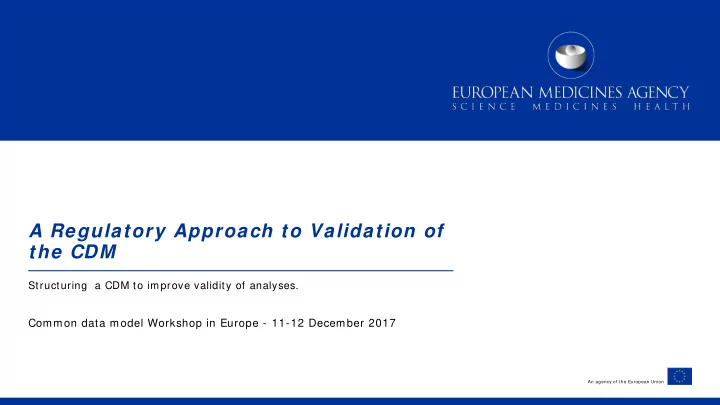

A Regulatory Approach to Validation of the CDM Structuring a CDM to improve validity of analyses. Common data model Workshop in Europe - 11-12 December 2017 An agency of the European Union
Requirem ents for regulatory evidence Provide agreed, transparent decision process • Industry – Need clear study design criteria • Regulators – Need clear assessment criteria • Public – Need to understand and trust process Scientifically sound Clinically convincing Evidence generation processes verifiable
W HY HAVE PRESPECI FI ED, PROSPECTI VE I NTERVENTI ONAL STUDI ES AND, I N PARTI CULAR, RCTS BEEN PREFERRED TO RETROSPECTI VE OBSERVATI ONAL STUDI ES I N REGULATORY DECI SI ON MAKI NG?
Variable m easurem ent I nterventional study Observational data Pre-specified uniform Variable must be inferred from a measurement criteria range of unsystematically recorded observations Pre-specified timing relative to treatment allocation Timing is not controlled Pre-specified interpretation of Variation across doctors in measurements preferred codes and propensity to record. Dedicated expert review temporally close to measurement if required
Allocation of treatm ent I nterventional study Observational data Study group selected – good? Treatment given selectively according to perceived patient need Use of placebo an option Not always clear that the prescribed Randomisation usual to ensure treatment has been taken or for how allocation independent of patient long characteristics Use of treatment can be checked Patients and clinical staff are aware that they are involved in a study
Data validation I nterventional study Observational data Standardised forms and trial Some data collection systems will management procedures check timing facilitate checks against medical notes and completeness of data Some statistical checks may be run but Major errors and omissions are queried remedial measures are usually crude – EG exclusion of whole practices Monitoring mandated Because the studies are not specified External inspections can be at the time of data collection, implemented concurrent validation cannot be focused.
Specification of analytical procedures I nterventional study Observational data Success criteria can be specified prior Best practice requires a formal to data collection protocol, stating success criteria, which should be prepared without prior looks • In an RCT these can be quite simple at the outcomes* treatment interaction. Analysis specified prior to data Analysis should be described in detail collection but lack of control over data collection Time points/ numbers of patients adds complexity. required pre-specified Decisions based on results always Control of multiplicity require post-hoc assessment of credible bias.
I m pact in term s of regulatory criteria I nterventional study ( RCT) Observational data Levels of evidence can be specified in In addition to statistical measures we terms of effect sizes and measures of must evaluate the extent to which we statistical significance trust the results. We believe that current regulatory and Even without deliberate malpractice company monitoring processes make many aspects of data quality and study deliberate malpractice difficult. design need to be assessed With current research environment, malpractice is not difficult
The current state of science is arguably very poor. For medical observational studies over 80% of initial claims failed to replicate, Ioannidis, JAMA, 2005, Young and Karr, Significance, 2011. Scientific fraud is common in retracted science papers, Fang et al., PNAS, 2012. So the evidence is that science claims usually fail to replicate and that fraud is being committed. Promoting transparency is a key to solving problems of validity and integrity. Stan Young
HOW COULD A VALI DATED COMMON DATA MODEL HELP TO CHANGE THE BALANCE ?
Possible CDM “package” Pre-specification of a selection of data sources Level of coding detail • High detail, possibly hierarchical systems to accommodate a wide variety of studies • Only major details to allow broad-brush epidemiology Concurrent validation of data • Credible differences between databases • Checks against national statistics
Possible CDM “package” Automated recording of analyses • What was done • Versions of data-bases Gatekeeper role? • Some data ONLY accessible via CDM
Variable m easurem ent Many useful concepts pre-defined • An important reduction in multiplicity concerns With pre-specification of selected databases, a potential to standardise some recording practices across databases
Allocation of treatm ent Unchanged
Data validation Validation checks can be pre-specified and periodically repeated Pre-specification of databases would allow monitoring of coding procedures and completeness Established validity – or lack of validity – can be taken into account in specifying analyses.
Specification of analytical procedures If the system records analyses this adds a level of verification • Can protect against inappropriate prior inspection of data • Can allow exact replication and additional sensitivity analyses
Regulatory verification If system also has a gatekeeper role some data can be reserved for checks Multiple databases allow assessment of heterogeneity of treatment effects across the health systems represented
Conclusions A carefully designed CDM has many attractions from a regulatory point of view Cannot solve all the challenges of observational data analysis but can provide an environment that limits some of the potential sources of bias and facilitates verification
THE END
Any questions? European Medicines Agency 30 Churchill Place • Canary Wharf • London E14 5EU • United Kingdom Telephone + 44 (0)20 3660 6000 Facsim ile + 44 (0)20 3660 5555 Send a question via our w ebsite www.ema.europa.eu/ contact Follow us on @EMA_ New s
Recommend
More recommend